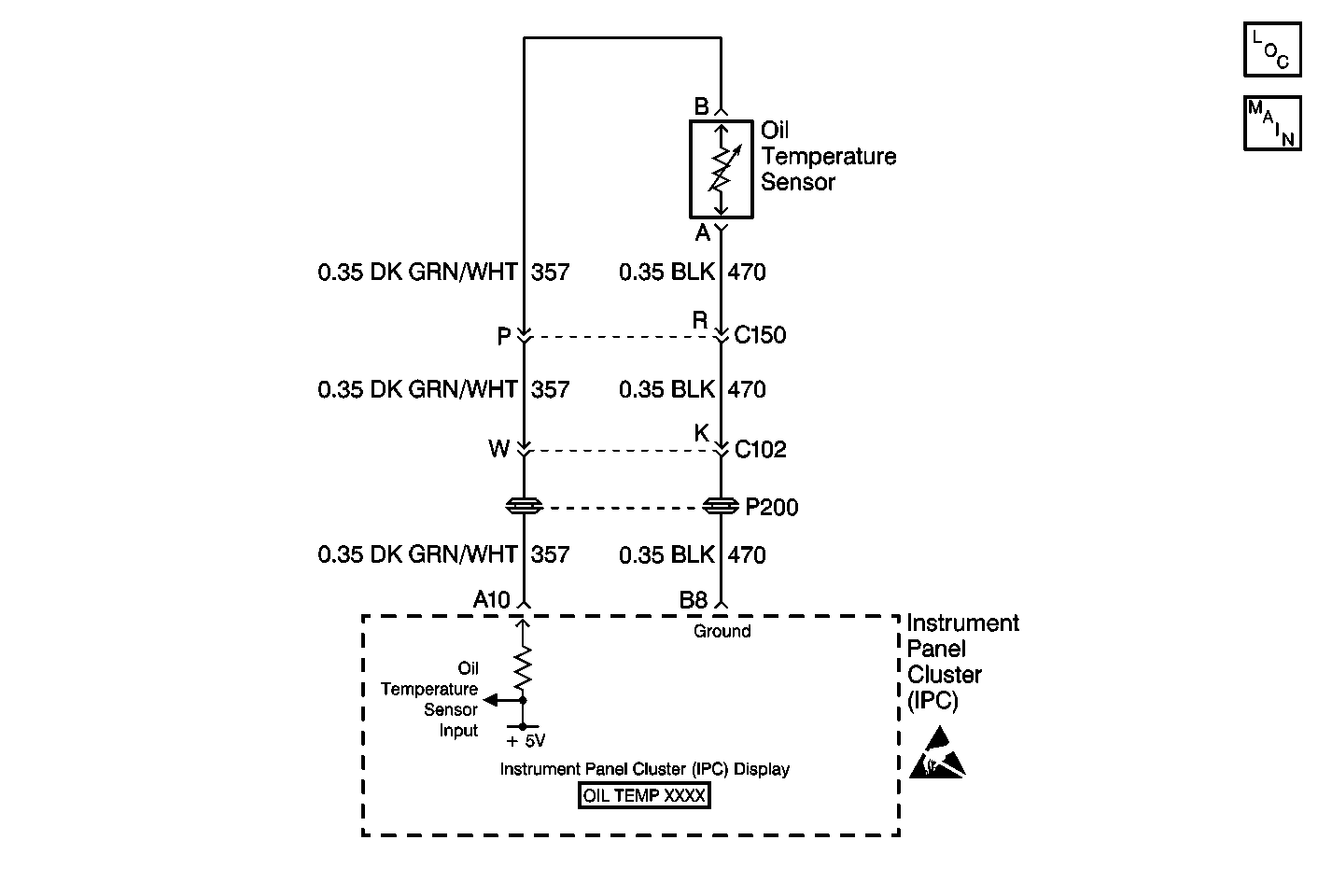
Circuit Description
The Instrument Panel Cluster (IPC) receives oil temperature information from the oil temperature sensor. The oil temperature sensor is a thermistor type sensor, which will produce high resistance with low engine oil temperature, while low resistance with high engine oil temperature. The IPC supplies a 5 volt reference signal to the oil temperature sensor. When the engine oil is cold, the sensor resistance will decrease, and the IPC reference voltage level will drop. The IPC measures the reference voltage change and displays the calculated value on the gauge.
Conditions for Setting the DTC
| • | The IPC detects oil temperature above 190°C (374°F). |
| • | The IPC detects a low voltage level (short to ground) in oil temperature CKT 357. |
| • | Condition must be present for 1 second. |
Action Taken When the DTC Sets
| • | Stores a DTC B1542 in the IPC memory. |
| • | Displays oil temperature over 190°C (374°F). |
| • | Displays oil temperature at 392°C (200°F) if CKT 357 is shorted to ground. |
| • | The IPC will display the HIGH OIL TEMPERATURE REDUCE ENGINE RPM message. |
Conditions for Clearing the DTC
| • | The IPC detects oil temperature less than 190°C (374°F) |
| • | The IPC does not detects a low voltage level (short to ground) in oil temperature CKT 357. |
| • | A history DTC will clear after 50 consecutive ignition cycles if the condition for the malfunction is no longer present. |
| • | Use the IPC clear DTC feature. |
| • | Use a scan tool. |
Diagnostic Aids
| • | The following conditions may cause an intermittent malfunction to occur: |
| - | An intermittent short to ground in the oil temperature circuit (CKT 357). |
| - | An internal short to ground in the oil temperature sensor. |
| • | If the oil temperature sensor or CKT 357 is shorted to ground, the IPC will display a constant oil temperature at 392°C (200°F). |
| • | Check if the IPC is able to recognize a change in resistance from the oil temperature sensor by disconnecting the oil temperature sensor. If the IPC oil temperature display changes from HIGH temperature (above 190°C [200°F]) with sensor connected, to LOW temperature (-10°C [14°F]) with the sensor disconnected. Then the IPC and CKT 357 is not cause of the malfunction and the oil temperature sensor must be checked. |
Test Description
The numbers below refer to the step numbers on the diagnostic table:
-
This test checks the oil temperature data using a scan tool. The scan tool will display oil temperature as 392°C (200°F) if there is a short to ground in the oil temperature CKT 357 or the oil temperature sensor.
-
This test checks if the oil temperature sensor circuit is shorted to ground by disconnecting the oil temperature sensor. The scan tool will display oil temperature less than -10°C (14°F) when the oil temperature sensor is disconnected and CKT 357 is not shorted to ground.
-
This test checks if the IPC is able to send a 5 volt reference to the oil temperature sensor.
Step | Action | Value(s) | Yes | No |
|---|---|---|---|---|
1 | Were you sent here from the IPC Diagnostic System Check? | -- | ||
Using a scan tool, select IPC data display and monitor the oil temperature data. Does the scan tool display oil temperature data greater than the specified value? | 190°C (374°F) | |||
Does the scan tool display oil temperature data less than the specified value? | -10°C (14°F) | |||
At the oil temperature sensor connector (harness side), measure the voltage between terminal B and ground. Was the voltage indicated between the specified value? | 4.5-5.5 V | |||
5 | Check for a short to ground in CKT 357. Was a problem found and repaired? | -- | ||
6 | Replace the oil temperature sensor. Is the replacement complete? | -- | -- | |
7 | Check the oil temperature sensor circuit for an intermittent malfunction. Refer to Diagnostic Aids. Was a problem found and repaired? | -- | ||
8 |
Does DTC B1542 set as current? | -- | System OK | |
9 | Replace the Instrument panel cluster. Refer to Instrument Cluster Replacement . Is the replacement complete? | -- | -- | |
10 |
Is the repair complete? | -- | -- |
